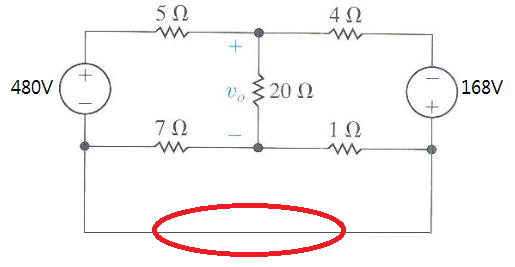You can consider that wire as being one big node. I suggest you redraw the circuit in such a way that you replace the encircled wire with a node.
I don't understand why the bottom wire can be ignored.
It is not short circuit since it does not directly connect two terminals of the same element.
To solve for the output voltage $v_o$ I suggest you use the Millman method:
$$\varphi_1 - \varphi_3 = 480$$
$$\varphi_2 - \varphi_3 = -168$$
$$\varphi_+ (\frac{1}{5} + \frac{1}{4} + \frac{1}{20}) = \varphi_1 \frac{1}{5} + \varphi_2 \frac{1}{4} + \varphi_- \frac{1}{20}$$
$$\varphi_- (\frac{1}{7} + \frac{1}{1} + \frac{1}{20}) = \varphi_3 \frac{1}{7} + \varphi_3 \frac{1}{1} + \varphi_+ \frac{1}{20}$$
The above equations can be written in matrix form:
$$
\left[
\begin{array}{cc}
\frac{1}{2} & -\frac{1}{20} & -\frac{1}{5} & -\frac{1}{4} & 0 \\
-\frac{1}{20} & \frac{167}{140} & 0 & 0 & -\frac{8}{7} \\
0 & 0 & 1 & 0 & -1 \\
0 & 0 & 0 & 1 & -1
\end{array}
\right]
\left[
\begin{array}{c}
\varphi_+ \\
\varphi_- \\
\varphi_1 \\
\varphi_2 \\
\varphi_3
\end{array}
\right]
=
\left[
\begin{array}{c}
0 \\
0 \\
480 \\
-168
\end{array}
\right]
$$
There are 5 unknowns and 4 equations, which means the system of equations is underdetermined. If we choose $\varphi_3$ as independent variable, the solution to the above equation is:
$$
\left[
\begin{array}{c}
\varphi_+ \\
\varphi_- \\
\varphi_1 \\
\varphi_2
\end{array}
\right]
=
\left[
\begin{array}{c}
\frac{180360}{1663} \\
\frac{7560}{1663} \\
480 \\
-168
\end{array}
\right]
+
\left[
\begin{array}{c}
1 \\
1 \\
1 \\
1
\end{array}
\right]
\varphi_3
$$
The output voltage is then
$$v_o = \varphi_+ - \varphi_- = 103.9 \text{ V}$$
Although the potential $\varphi_3$ is independent variable, it does not affect voltage calculation since it cancels out when subtracting potentials. For this reason we usually set one potential (any one!) to zero which mimics ground connection and makes matrix manipulation much easier. I suggest you solve this problem by taking some other potential as independent variable, you should get the same final result.





